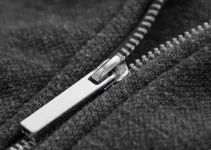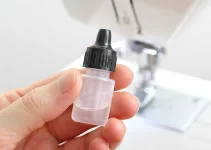Answering the question does fleece shrink is going to take us into the world of synthetic fabrics. I just wanted to mention that from the beginning because some of you might think that fleece has something to do with wool.
On the contrary, fleece is a totally synthetic fabric, it might even be defined as a man-made wonder product. It’s just named after the coat of sheep, from which wool is subsequently made, but it has nothing in common with wool.
Well, it’s called a vegan alternative to wool so that might be the thing it has in common with wool.
Therefore, upon learning that fleece is totally synthetic, you might assume that the answer to the question does fleece shrink is a resounding no. After all, most of us know that polyester is resistant to shrinking and durable.
Would you be right to assume that fleece doesn’t shrink under any conditions?
For example, when I wrote my article on the question is rayon stretchy, we discovered that viscose rayon is a semi-synthetic fabric that can easily shrink under heat conditions, when it’s washed, dried or ironed. Thus, we are usually advised to wash our viscose rayon garments in cold water and to air dry them.
Let’s get back to seeing if fleece has that shrinking possibility in common with rayon or if this synthetic is totally easy to handle.
Does Fleece Shrink? In General, It Doesn’t
If your fabric is made from synthetic polyester fleece, then the answer to the question does fleece shrink is no.
Totally synthetic fleece doesn’t shrink either in the washer or the dryer. Those who assumed that synthetic polyester fleece is safe from shrinking were right.
However, polyester fibers can melt if the temperature in the dryer is just too hot.
It’s always good to read the labels that come with our clothes and follow their recommendations, just to be totally sure that we’re treating our garments the way they should be washed, dried, ironed, etc.
If your garment is made with fleece made from cotton, there’s a very tiny risk that it might shrink if we use heat when washing and drying it.
Cotton can shrink, which might happen in a dryer when it’s exposed to heat. There’s a small chance that 100% cotton fleece will shrink but it’s always good to be careful at first.
That’s why it’s best to read the labels. You should always make sure that you’re using the right washing and dryer temperature not only because it will prevent fabrics from shrinking but also because it will make the fibers last longer.
I also don’t remove any labels until I have washed and dried the garment a few times so that I know from memory which fabric or fabric blend might necessitate special care.
What Is Fleece? (polyester fleece)

For most of us, fleece is that cozy material that keeps us warm. If you’re a fan of the outdoors, hiking and camping or if you live in very cold regions, then you’re highly accustomed to having a bunch of fleece pieces in your closet.
The general answer to what is fleece is that fleece is a synthetic insulating fabric made from polyester. The polyester in question is called polyethylene terephthalate (PET). It can also be made from other synthetic fabrics.
Polyester can be made from a chemical reaction involving petroleum, air and water.
Or it can be made from recycled plastic bottles.
Fleece is a synthetic fabric. It is originally derived from plastic. Thus, it has absolutely nothing in common with wool, it’s just named after the material from which wool is made.
It’s always surprising to think that our plastic bottles are used to make fabrics, they’re recycled into polyester. If you’re interested in how the whole process goes, I found this YouTube video that explains how plastic bottles are made into polyester fabric.
Besides the fact that polyester fabric is made from recycled plastic bottles or from a chemical reaction involving petroleum, air and water, what fascinates me the most is that fleece is so fuzzy and soft to touch. It’s an extremely soft, warm and breathable fabric with awesome insulating properties.
Thus, it might be pretty easy to see why fleece is regarded as a man-made wonder product.
All in all, fleece is perfect for outerwear and cozy products. And, thankfully, the answer to the question does fleece shrink is that polyester fleece doesn’t shrink. We can be warm and cozy and not worry about special washing or drying conditions.
Polyester fleece vs Cotton fleece
When I answered the question does fleece shrink, I made a distinction: polyester fleece doesn’t but cotton fleece might.
To give you some simple advice, we should always read the labels accompanying our garments or blankets or towels or whatever else we buy. It’s like reading a user manual for our new sewing machine. Both things must always be done.
Plus, we shouldn’t forget about fabric blends either. Cotton-polyester blends (80%/20% or 60%/40%) are pretty common. But 100% cotton fleece is the most common.
We already saw what polyester fleece is right above. Let’s talk about cotton fleece.
What we can say is that 100% cotton fleece is very different from polyester fleece because it has the characteristics of cotton.
Thus, it won’t retain heat as well as polyester. That’s an important characteristic to keep in mind because fleece is famous for its insulation and heat-retention properties. If you’re looking for those properties, choose polyester.
Cotton-polyester blend/polyester is the best fleece
If you are looking for garments and objects that provide warmth, then you should choose polyester fleece. This is the type that provides good insulation and maintains heat.
Cotton fleece is more porous and it loses heat more easily.
However, cotton is considered to be more comfortable. It’s soft, light to wear in hot weather and breathable.
Moreover, polyester dries quickly because it doesn’t retain moisture. It’s an important aspect for those who go camping for longer periods of time. Plus, in the winter, we want our clothes to dry more quickly. Cotton takes longer to dry so it’s not ideal for colder months.
However, a cotton-polyester blend of 80%/20% is quite good for the colder months. These fabric blends are also ideal for thermal conductivity. They’re better at keeping the heat in.
All in all, cotton-polyester blends are becoming increasingly popular because they bring forth the best characteristics of both fabrics. This is the fleece that we want to see in our garments. Or we can just stick to 100% polyester.
Read my guide on how to spray paint fabric if you’re interested in some creative DIY projects.
Fleece is a medium weight fabric
This might be interesting information for those who want to use fleece to sew their own clothes or blankets at home.
If we know that fleece is a medium weight fabric that means that we don’t necessarily need a heavy duty sewing machine to make our clothes or blankets or other objects.
Even a cheaper and not-so-powerful sewing machine can work for this fabric. Of course, a powerful sewing machine is always a good thing to own but you can sew through fleece layers with a cheaper machine, too.
Just make sure to use polyester thread and the right needles for medium weight fabrics.
Is fleece good for the environment?
If we look at polyester as being made from recycled plastic bottles, we would say that it’s a good idea because at least we get to use those plastic bottles instead of having them end up in oceans, seas, rivers and landfills.
However, that is only true for recycled polyester.
On the other hand, polyester can also be derived from a chemical reaction involving petroleum, air and water. In that case, we can say for certain that it’s not good for the environment since petroleum is a fossil fuel and we’re trying to cut down on using fossil fuels.
It’s true that polyester is absolutely awesome and an inexpensive way to dress for cold weather but, on the whole, I would say that it’s not the best fabric for the environment.
It also needs an extra chemical coating to make it windproof and water resistant. That doesn’t sound that great for the environment, either.
Recycled polyester is definitely better because it puts to use those plastic bottles that would otherwise be thrown away.
However, even for recycled polyester things are not all that black and white because it’s not biodegradable.
Moreover, a study under the title Microfiber Masses Recovered from Conventional Machine Washing of New or Aged Garments found that, when synthetic jackets are washed, on average, approx. 1.17 milligrams of microfibers are released.
Eventually, up to 40% of these microfibers can enter into rivers, lakes and oceans from the local wastewater treatment plant. And that’s how we get plastic in the oceans, even if we’re using recycled polyester fleece.
Nevertheless, if we are on a budget for our clothes or blankets, then fleece is one of the best fabrics that we have access to. We can’t all choose just natural fabrics all the time.
How to wash & dry fleece fabrics
I said that my answer to the question does fleece shrink is that polyester fleece doesn’t shrink. We can also have 100% cotton fleece garments or a cotton-polyester blend.
100% cotton fleece has a really tiny risk of shrinking if the dryer temperature is very hot.
For 100% polyester, there’s a tiny risk that fibers might melt at very high temperatures. Remember, polyester is made from recycled plastic bottles or from a petroleum, air and water chemical reaction.
Thus, the easiest thing to do is to read the labels and follow their instructions. Manufacturers do know best after all. Let’s see what other things you should keep in mind.
Use the normal cycle
You don’t need any special cycle for fleece. You absolutely have no use for the gentle cycle. It’s not a delicate fabric, whether it’s polyester, cotton or cotton-polyester blend.
If you’re washing a bunch of fleece blankets in the same cycle, you might want to use the heavy-duty cycle to make sure they’re cleaned thoroughly.
Wash with similar fabrics
It can ensure that the texture of the fleece fabric will be maintained for very long periods of time.
Do you need a mild detergent?
Frankly, I consider that most detergents from big brands are mild. If you buy a big brand detergent, that’s good enough for most of the garments and fabric objects that we own.
Dryer temperature
It should be set on low or medium heat.
With fleece, it’s not about how you handle the washing because that’s pretty straightforward. The way you dry the pieces is more important.
Air drying is recommended if you have 100% cotton fleece and you feel that your dryer gets too hot and you can’t change the cycle.
For 100% polyester and cotton-polyester blends, medium heat is good enough. It will prevent the fibers from damage, making the fabrics last longer.
Can you shrink fleece?
If you have a 100% polyester fleece, then you probably can’t shrink it because polyester is made to be resistant to shrinking.
If you get it into a very hot drier with the hope of shrinking the fabric, all you might achieve is damaging the fibers but the size would stay the same.
Cotton fleece has a very tiny chance of shrinking at hot temperatures but I would, once again, be concerned with damaging the fibers. I would definitely advise against it.
Thus, generally, you can’t shrink fleece at all. Once again, we are reminded that the answer to the question does fleece shrink is no.




